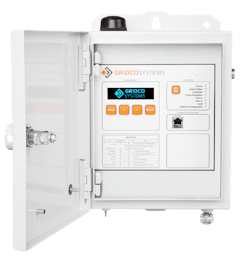The electric grid is a remarkable feat of engineering – so ubiquitous, reliable, and economical in its delivery of power that it is generally taken for granted. It is a true testament to the expertise of its utility engineers and operators. As robust as it generally is, a number of trends are beginning to stress the grid:
- Adoption of increasingly cost-effective, customer-owned distributed generation is affecting grid reliability, not to mention reducing volumetric utility sales revenue
- Increasing severity of weather systems is giving rise to larger scale power outages of longer duration and higher societal cost
- Increasing transmission and base-load generation capacity constraints are necessitating deeper levels of demand curtailment during peak periods
- Emerging load types, including electric vehicles and data centers, are introducing geographic pockets of intense load growth that can exceed existing thermal capacity limits, accelerating the aging of associated infrastructure or causing catastrophic equipment failures
- Increasing diversification of customer needs and the challenge of delivering consistent service levels across an entire service territory (due to weather-susceptible areas for example) are exposing inadequacies in the traditional rate-based recovery model in aligning localized customer needs with associated investments
- Increasing frequency of cyber-attacks targeted at the energy industry is threatening national security
Each of these trends contributes to the same fundamental challenge: How can utilities reliably and economically balance supply and demand in an environment characterized by decreasing direct control over supply, decreasing predictability of demand, tightening capacity constraints, and increasing susceptibility to outages and attacks?
Although every utility experiences these challenges to varying degrees, the directional trends are unwavering and ascendant. To witness the leading edge of such trends, one needs only to look to where both renewables penetration levels and electricity prices are highest. High electricity rates amplify the utility’s economic challenge, not just because of the higher rate pressures and associated political obstacles to further investment, but because higher electricity prices induce customers to more likely adopt distributed generation and/or combined heat and power systems, which in turn reduce volumetric sales, an economic spiral that feeds on itself. In such scenarios, solutions are needed now – solutions that consist of new technologies to cost-effectively address technical challenges like time-varying voltage rise and reverse power flow, and enable financial recovery mechanisms that allow utilities to transform the unidirectional distribution system of today into a bidirectional power exchange of tomorrow.
IT Applied
To address broad challenges, it is clear that infrastructural investments are necessary. Indeed, the last decade has seen significant adoption of information technologies as applied to the distribution grid, such as advanced metering, communications equipment, and data analytics. These technologies give utilities the eyes and ears needed to better understand the operational characteristics and performance of their grids. Although these ‘grid smarts’ are necessary components of a modernized grid, the ability to enact change in response to grid intelligence is the critical ingredient necessary to render a subsidy-free and systemic business case, one whose benefits exceeds associated costs and meets industry-standard cost-effectiveness tests without explicit reliance on societal benefits.
In the context of the distribution system, current examples of the need to enact change in power flows are:
- regulating voltage in response to PV-induced voltage rise
- broadly reducing feeder voltage during peak periods for the purposes of demand reduction
- actively canceling harmonics induced by nonlinear and unpredictable loads
- dynamically load-balancing distribution transformers
- automatically rerouting power around failures
- efficiently deploying resources to address impending asset failures
- sequentially activating loads upon large-scale outages, amongmany others.
In each of these cases, a source of monetizable value can be realized, whether derived from reliability, power quality, efficiency enhancements, avoided future capital expenses, or reduction in operational expenses.
Unlike the information technologies underlying ‘grid smarts,’ the technologies required to enact change must necessarily process power in a dynamic and adaptive fashion; that is, have the ability to adapt their regulation response to changing grid conditions and on sufficiently small timescales, providing for ‘grid agility.’ Unlike ‘grid smarts,’ this new class of active grid infrastructure for the distribution system has seen minimal investment and innovation until recently, with past investments focusing mostly on automating existing electromechanical devices like load tap changers, capacitor banks, and voltage regulators, or development of single-function power-electronics devices like D-STATCOMs, all of which are focused only on the medium voltage (primary) side of a distribution feeder.
Distributed, Dynamic and Decoupled
As will be described in upcoming articles, a new class of active grid Infrastructure is now available, one that is inherently multifunctional and distributed, dynamic, and decoupled in nature. “Distributed” addresses the spatial asymmetry of load growth and distributed energy resources. “Dynamic” addresses the decreasing time-scales and increasing magnitudes of power quality deviations, and “decoupled” ensures system-wide stability and operational simplicity. Such solutions, based on advances in power electronics and distributed controls, can immediately address:
- applications including residential and utility-scale PV integration
- enhancement of existing CVR and/or peak demand reduction program
- improvement of fault detection, isolation and restoration (FDIR) programs
- power quality assurance for sensitive loads
Moreover, such multifunction solutions exhibit strong, subsidy-free benefit-to-cost ratios that enable utilities to economically address the challenges of today while preparing for the challenges of tomorrow.
Naimish Patel is CEO of Gridco Systems, a provider of intelligent power control and management solutions for the 21st century electric grid. Previously, he served as Entrepreneur in Residence at General Catalyst Partners, where he focused on investment opportunities in clean technology, advanced materials and life sciences. Prior to his role at General Catalyst, Patel was co-founder and chief technology officer (CTO) at Sycamore Networks, a leading provider of optical networking solutions for mission-critical networks. He holds BS, MS, and MEng degrees in electrical engineering from the Massachusetts Institute of Technology (MIT) and is the holder of 18 patents.



